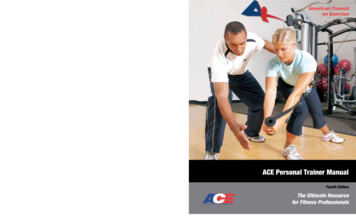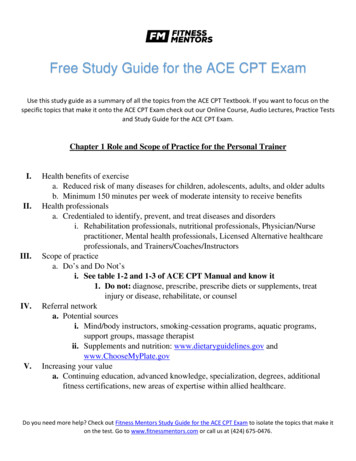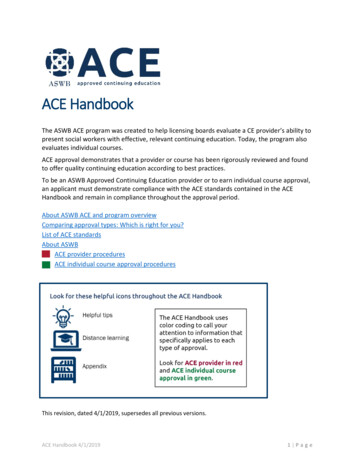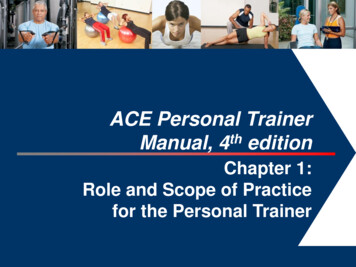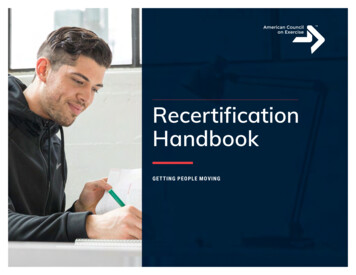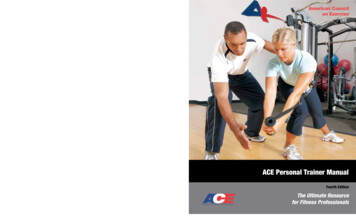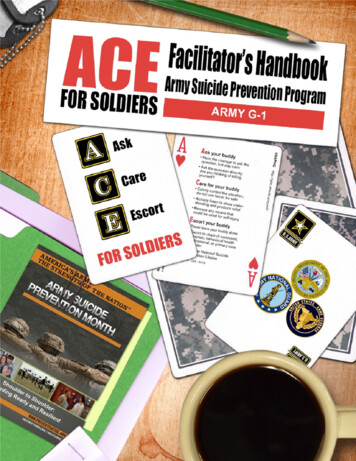
Transcription
16 December 2013ACE FACILITATOR’S HANDBOOKVersion 1.0ACE FOR SOLDIERS FACILITATOR’S HANDBOOKPREFACE . 1Preparation Checklist for the ACE for Soldiers Training Facilitator . 2BEFORE CONDUCTING THE TRAINING. 2ON THE DAY OF THE TRAINING . 2AFTER THE TRAINING. 2Information for the ACE for Soldiers Training Facilitator . 3Important Precautions. 3Learning Objectives for ACE for Soldiers . 3Additional Resources for Conducting ACE for Soldiers Training. 4FACILITATION TIPS . 5Materials to conduct the ACE for Soldiers training: . 5Terms and Definitions . 6Regulatory Guidance . 7ACE FOR SOLDIERS TRAINING . 8Slide 1: ACE for Soldiers – Introduction . 8Slide 2: Be Aware of What is in Your Ruck . 10Slide 3: Warning Signs . 13Slide 4: If You See Warning Signs – ASK!. 16Slide 5: Really Listen and CARE! . 18Slide 6: ESCORT is Your Duty! . 21Slide 7: Role Play Exercise . 22Slide 8: Stigma . 24Slide 9: Emergency Resources . 26i
16 December 2013ACE FACILITATOR’S HANDBOOKVersion 1.0Slide 10: Summary. 28APPENDIX A – EXERCISE HANDOUT. A-1Identification of Warning Signs . A-1Role Play . A-2APPENDIX B – ACE FOR SOLDIERS SIGN-IN . B-1ii
16 December 2013ACE FACILITATOR’S HANDBOOKVersion 1.0PREFACEDownload the ACE for Soldiers slides and the ACE for Soldiers Facilitator’s Handbook from theArmy G-1, Army Suicide Prevention Program www.preventsuicide.army.mil website. Reviewthe other resources available at the website for your use.Read this brief ACE for Soldiers Facilitator’s Handbook before conducting the ACE for Soldierstraining. The ACE for Soldiers Facilitator’s Handbook contains the following: A checklist to help you prepare to conduct and report on the ACE for Soldiers training. Tips on facilitating the training. A thumbnail picture of each slide in the training plus the following information:o Directions.o Talking points.o Example speaker’s notes to help you prepare to talk about each section of thetraining. Exercises to conduct during the training. Additional information that you may find helpful when conducting ACE for Soldiers.1
16 December 2013ACE FACILITATOR’S HANDBOOKVersion 1.0Preparation Checklist for the ACE for Soldiers TrainingFacilitatorBEFORE CONDUCTING THE TRAININGContact the unit/organization or Suicide Prevention Program Manager (SPPM) to coordinatea date, suitable location, and participants for the training.Coordinate with the SPPM to contact the unit/organization’s chaplain, chaplain assistant, ora behavioral health counselor who will be “on call” during the training.The commander, XO, or representative is responsible for the following actions: Schedule dates for the training after consulting the appropriate command. Schedule training participants and provide you with a roster. Secure the location for training.Obtain a list of local resources and phone numbers from your unit or local SPPM. You canadd these to the final slide of the briefing or copy and hand them out in the training.Visit the scheduled room and check the following: Is the room large enough with seating for 30 students (approximately 800 square feet)?Is computer equipment available to project the slides, and are there sufficient electrical outlets?Do a live test of the slide projection.Get the name of the person to contact if there is a problem with the projection equipment.Is there a clock in the room? If not, be sure to bring a way to time the training. One copy of the sign-in sheet.One copy (double-sided if possible) of the ACE for Soldiers Facilitator’s Handbook for your use.Optional: print a copy of the slides with slide notes to use as you conduct the class.A copy of the handouts for each participant.A copy of the local resources/phone numbers provided by the unit or SPPM for each participant.Print:ON THE DAY OF THE TRAININGArrive early with slides, this handbook, handouts, equipment, and a timepiece.Test the equipment to be sure the slides are working properly.Arrange the chairs and tables into small group work areas if possible.Put up suicide prevention posters (provided by the SPPM or unit), if available.Recheck your classroom crisis back-up (call Chaplain or other back-up to remind / confirm).Place the sign-in sheet and a pen on a desk near the door.AFTER THE TRAININGEnsure all training participant’s names are printed clearly on the sign-in sheet to documentfulfillment of annual ACE for Soldiers training requirement.Remain in the room for at least 15 minutes to allow participants to speak with you or askquestions as needed.Deliver a copy of the sign-in sheet to the unit training officer (or SPPM as directed) for entryinto DTMS and each Soldier’s Individual Training Record.2
16 December 2013ACE FACILITATOR’S HANDBOOKVersion 1.0Information for the ACE for Soldiers Training FacilitatorACE for Soldiers is a 90-minute classroom training package that includes: slides; slide notesgiving directions and talking points; this ACE for Soldiers Facilitator’s Handbook providing apicture of each slide, directions for use, talking points, and Example Speaker’s Notes that can beused for ideas on training facilitation; and group activities/exercises for participant interactionand skills practice.Review the slides; read the Handbook facilitation tips, directions, talking points, examplespeaker’s notes, exercises, and additional information before the day of the training. Atapproximately the halfway point in the training, at Slide 5, allow training participants a 10minute break. This training is most effective when used with a maximum class size of 30 anda minimum class size of 8. If you need to train more than 30 people, divide them into twoclasses.Important PrecautionsThe ACE for Soldiers training deals with sensitive information and may trigger painful memoriesor other issues for training participants. Some people taking the training may themselves beexperiencing thoughts of suicide. Be aware of this as you conduct the training. If you are not achaplain or behavioral health provider, before conducting the training, call the chaplain's officeor the behavioral health office, request and speak directly with someone who will be availableto provide immediate help during your training session if required. Give the person the date,time, and location of the training; obtain their name, title, and consent to act as an immediateresource if needed; obtain, and keep at hand (program into your mobile device), their mobile aswell as office phone numbers to use in case of need.If during the training someone asks a question for which you do not have an answer, just say, “Idon’t know the answer but I will find it for you.” After the training, follow up to find theinformation and answer the question for the person who asked. Good sources for additionalinformation about suicide prevention include the Army G-1, Army Suicide Prevention Programwebsite at www.preventsuicide.army.mil, the DoD Suicide Prevention Office (DSPO) athttp://suicideoutreach.org/, your Suicide Prevention Program Manager (SPPM), or your localchaplain. Some helpful additional background information is included in your ACE for SoldiersFacilitator’s Handbook in the Facilitator’s Notes.Learning Objectives for ACE for SoldiersDemonstrate an understanding of the Ask, Care, and Escort (ACE) method of suicideprevention:A. Describe risk and protective factors that impact suicide.3
16 December 2013B.C.D.E.ACE FACILITATOR’S HANDBOOKVersion 1.0Recognize warning signs of suicide.Define the three steps of the ACE method of suicide prevention.Describe the Soldier’s role in reducing and preventing stigma.Identify emergency and non-emergency resources.Additional Resources for Conducting ACE for Soldiers TrainingLocate or create a list of local resources. In most cases, the unit or the nearest SPPM will havealready compiled this information; ask for a copy. You can also find a Community ResourceGuide link on the Army G-1, Army Suicide Prevention Program website atwww.preventsuicide.army.mil . If possible, make a copy of your local resources to hand out toeach training participant. The final slide of the briefing is left blank for your use. You cancustomize it with your unit logo, local resources, tools, policies or POCs as required. You canalso list the resources on a white board or flip chart in the classroom.If possible, obtain ACE tip cards from your SPPM to hand out during the training. They can alsobe ordered online through the Army G-1, Army Suicide Prevention Program Website located atwww.preventsuicide.army.mil . Click on “Training” in the left hand sidebar of the home pageand follow the “Training Videos, Tip Card and more ” link.You can also ask the SPPM to provide you with suicide statistics for your installation, state, orregion so that you can share these with training participants. The suicide rate for Soldiers wenthigher than the rate for civilians for the first time in 2008. The suicide rate for all the Services,as well as for civilians, has continued to rise.The ACE for Soldiers training is a key component of the overall suicide prevention efforts of theArmy. Your role as facilitator of this training is very important! ACE for Soldiers helps to makeSoldiers aware of the problem of suicide, enables them to recognize when a fellow Soldierexhibits warning signs, and equips them with the knowledge and skills to apply the Ask, Care,Escort method of suicide prevention.The ACE for Soldiers Facilitator’s Handbook provides “Example Speaker’s Notes” withsuggestions for how you can present and discuss each slide. DO NOT read the examplespeaker’s notes to the training participants; instead review the notes ahead of time tofamiliarize yourself with the content; during the actual training use the talking points anddirections provided in the slide notes to talk about the material in your own words. In trainingsessions with Active Component, National Guard, Army Reserve, Army Civilian, or Familymember training participants, be sure that your statements and language are inclusive of allparticipants.4
ACE FACILITATOR’S HANDBOOK16 December 2013Version 1.0The sign-in sheet must be readable. ACE for Soldiers is an annual training requirement forevery Soldier and must be reported in the Digital Training Management System (DTMS) andeach Soldier’s individual training record. Your job, as facilitator, is to provide the sign-in sheetand the date that the training was conducted to the appropriate unit training officer or noncommissioned officer (NCO) in order to complete this requirement.Note the approximate time for discussing each slide provided in the ACE for SoldiersFacilitator’s Handbook. If possible, before conducting the class for the first time, practice howyou will use the slides, notes and exercises and time yourself to ensure that you allow adequatetime for each section.Good facilitation includes keeping the training participants’ attention by using a variety ofpresentation techniques.Spend no more than 10 or fewer minutes at a timespeaking/presenting information and then use the group activities/exercises, questions, ordiscussions to change the pace of the training. Below are some additional tips for good trainingfacilitation:FACILITATION TIPSDO DON’T Let discussions ramble. Talk so much that it discourages groupparticipation. Let misinformation go uncorrected. Be insensitive to the experiences ofindividuals in the class. Allow one or more people to dominate thetraining or the group. Allow any participant to belittle otherparticipants, use disparaging or derogatorylanguage, or perpetuate stigma. Lose sight of the objectives or control of thediscussion. Lose control of time.Set aside personal opinions.Familiarize yourself with all content.Speak in simple, direct language.Create an open and trusting atmosphere.Encourage everyone to participate, but don’tforce anyone.Ensure everyone is treated with respect.Listen to all comments, validate those that aregood, and keep the discussion on track.Correct statements contrary to Army policy.Maintain a high energy level.Remain flexible.Manage your time.End on a positive note.End on time.Materials to conduct the ACE for Soldiers training: Sign-in sheet with space for training participant’s name and unit.Printed copies of your local resource list and handouts (one for each participant).ACE cards (one for each participant).One copy of the ACE for Soldiers Facilitator’s Handbook downloaded from Army G-1,Army Suicide Prevention Program website for your own use in conducting the training.5
16 December 2013 ACE FACILITATOR’S HANDBOOKVersion 1.0ACE for Soldiers PowerPoint Slides downloaded from the Army G-1, Army SuicidePrevention Program website to a disc or laptop so that you can display the slides whenyou conduct the ACE for Soldiers training.A method for projecting slides.Terms and DefinitionsProtective Factors: Protective factors are skills, strengths, or resources that help people dealmore effectively with stressful events. Protective factors enhance resilience and help tocounterbalance risk factors (negative life events such as academic, occupational, or socialpressures). Protective factors may be personal, external, or environmental. They reduce thelikelihood of attempting or completing a suicide. (www.suicideoutreach.org)Risk Factors: Risk factors refer to an individual's characteristics, circumstances, history andexperiences that raise the risk for suicide. Experiencing one of these does not necessarily meanthat a person is contemplating suicide or self-harm. However, these negative experiences doincrease the risk of suicidal behavior when compared with individuals who have notexperienced such events. (www.suicideoutreach.org)Warning Signs: Suicide is the deliberate taking or ending of one's own life. It is oftenassociated with a severe crisis that does not go away, that may worsen over time, or that mayappear hopeless. Friends or loved ones in crisis may show signs that indicate that they are atrisk of attempting or dying by suicide. (www.suicideoutreach.org) While some suicides occurwithout any obvious warning, most individuals considering suicide do give warning signs such asthe following: noticeable changes in behavior—sleeping, eating, hygiene, mood (depression,sadness, hopelessness, helplessness, anger, irritability, anxiety); isolating yourself; drug use orincreased alcohol use; talking and/or hinting about suicide in words, texts, Facebook posts—saying you feel like dying, or you can't go on, or your family would be better off without you;finalizing personal affairs—giving away things you care about or suddenly making a will; feelingsof sadness, hopelessness, helplessness—feeling that things can never get better; increasingrelationship problems, financial problems, legal problems; sudden or impulsive purchase of afirearm or obtaining other means of suicide, such as poisons or medications. (DA PAM 600-24,Health Promotion, Risk Reduction, and Suicide Prevention)Stigma: The perception among leaders and Soldiers that help-seeking behavior will either bedetrimental to their career (e.g., prejudicial to promotion or selection to leadership positions)or that it will reduce their social status among their peers. (Army Health Promotion RiskReduction Suicide Prevention Report 2010 Glossary)6
16 December 2013ACE FACILITATOR’S HANDBOOKVersion 1.0Regulatory GuidanceIn accordance with AR 600-63, Army Health Promotion, Ask, Care, Escort (ACE) for Soldiers is a90-minute annual suicide prevention and awareness training required for Soldiers serving in theActive Army, ARNG, and USAR. ACE is the Army-approved suicide awareness and trainingmodel. The key learning objectives of ACE for Soldiers are awareness of risk factors, warningsigns, and resources and using the ACE model. Training should be conducted in person and insmall groups, to the extent possible, rather than using large groups, video teleconference, orWeb-based training. Completion of the training will be documented in the Digital TrainingManagement System (DTMS) and the Individual Training Record. Department of the ArmyPamphlet (DA PAM) 600-24, Health, Promotion, Risk Reduction, and Suicide Prevention,provides additional information and guidance regarding this training.7
16 December 2013ACE FACILITATOR’S HANDBOOKVersion 1.0ACE FOR SOLDIERS TRAININGSlide 1: ACE forSoldiers –IntroductionDirections (5 minutes): Have a sign-in sheet near the door and Slide 1 displayed as studentsenter the room. Arrange chairs in small groups if possible or designate small group seatingareas by directing Soldiers to seating as they enter the room. (This training is most effectivewhen used with a maximum class size of 30 and a minimum class size of 8.) Read the ExampleSpeaker’s Notes for ideas then use the talking points to introduce the training in your words.Talking Points: Course Title/sign-in for credit for annual requirement.Housekeeping details.Speak with me first if you need to leave the training.Someone is standing by to talk if anyone needs to do so.Put the Military Crisis Line number in the contact list of your mobile - turn off sound - keephandy to use later in class. Online chat is also available at the website on the slide.Protect privacy of others as we discuss things.Today you will learn to use the A-C-E immediate action drill to prevent suicide.Show of hands – who knows CPR if we had an emergency in our classroom? ACE (ASK,CARE, ESCORT) training prepares you to give assistance for an emergency too; it helps youbecome aware of warning signs of suicide so that you know how to respond.Example Speaker’s Notes:I am (your name and job title). This is the Ask, Care, Escort (ACE) training for Soldiers. Be sureyour name and your unit are legible on the sign-in sheet. This training fulfills the requirement forannual suicide prevention awareness training for all Soldiers. The training is 90 minutes longwith one 10 minute break. ACE training does two things: increases your awareness about theproblem of suicide—the deadliest enemy the Army has — and teaches you an immediate actiondrill to help combat it!8
16 December 2013ACE FACILITATOR’S HANDBOOKVersion 1.0Many of us may know of someone who died by suicide. Some of us may know someonepersonally or even have had thoughts about suicide ourselves. Remember there are individualsin this community who can help. If you’re not already familiar with the Military Crisis Line, youshould be. You can call this number for help at any time—for you or someone else—or to getadvice on how to talk to someone you’re concerned about. A live person answers and can helpyou immediately. Take out your mobile device and put this number (800-273-8255) into yourcontacts list right now. Turn off the sound, but leave the phone on; we will use it again in thetraining. If you don't have your phone, make a note of this number and program it in later.Remember that if you have had a personal experience with a Soldier or other person who hasattempted suicide or died by suicide, please do not share the names or identifiable details aboutthe person or the incident during the group discussions—this can violate the person’s or family’sright to privacy. If you need to talk about a specific situation or person that you believe needshelp, please talk to me at the break or atFACILITATOR NOTE:the conclusion of today’s training; I willAnswer any questions that training participants may haveconnect you with someone who will helpand then proceed with the training. If a question arises forimmediately.which you do not know the answer, get the questioner’sname and contact information, locate the answer for themafter the training, and contact them to provide the answer.The key knowledge point for Slide 1 is to introduce yourselfand the training; provide housekeeping details; informtraining participants that someone is available to talk tothem immediately if they have a concern; capture theirattention; and provide a brief description of the training.Good sources for additional information about suicideprevention include the Army G-1, Army Suicide PreventionProgram at www.preventsuicide.army.mil, the DoD SuicidePrevention Office (DSPO) at http://suicideoutreach.org/,your Suicide Prevention Program Manager (SPPM), or yourlocal chaplain.)Last, I want to be clear about this: it isnot the Army's goal to make you anexpert on suicide or behavioral healththrough this training. The Army does notexpect you to diagnose illness or toprovide counseling or treatment. Whatyou will learn is another kind of firstaid—an immediate action drill to save alife by using ACE when you recognizewarning signs of a potential suicide.All of you are familiar with the SoldiersCreed, the Warrior Ethos, Army values. As Soldiers we have to depend on each other on and offthe battlefield. We have a duty to have each other’s backs and to never leave a fallen comrade.Part of that duty is learning to recognize when someone may need help and learning what to doto offer that help.Any suicide is a tragedy for the Family, friends, and co-workers of the person who dies. TheArmy wants to reduce the suicide rate as much as possible. What you will learn today is howyou personally can use the A-C-E (ASK, CARE, ESCORT) immediate action drill to help preventsuicides. This training will help you become aware of warning signs, committed to helpingyourself and others, and effective at doing so! Are there any questions?9
16 December 2013ACE FACILITATOR’S HANDBOOKVersion 1.0Slide 2: BeAware of What isin Your RuckDirections (Approximately 5 minutes to include activity/exercise): Display slide 2.Use the Talking Points to discuss this slide. Use the activity/exercise in the ACE for SoldiersFacilitator’s Handbook. To get additional ideas regarding how to talk about this section, readthe Example Speaker's Notes.Talking Points: Everyone has both risk factors and protective factors in their lives.Most of the time we can balance the load; but there are times when everyone needs somehelp to do that.When risk factors start to throw us off balance it is time to get help—talk to a friend andshare the load: talk to the chaplain or chain of command to locate the right kind of help; callMilitary One Source; look at your local resource list.What should you do about risk?o Compensate for risks that you cannot change.o Increase your protective factors. Use the performance triad—sleep, activity, nutrition.o Build strong relationships: Family, friends, fellow Soldiers, groups.o Avoid high risk behaviors like heavy drinking.o Get help when you need it—the earlier you get help with problems the faster you canget your life back in balance!Group Activity/ExerciseExample Speaker’s Notes:A lot of people have the wrong idea about risk. Everyone has risk factors. Risk Factors presentin your life may increase your risk of suicide but not always. Some risk factors are listed on theslide.So what do you do about risks? Well, some of them are within your power to change, like youruse of alcohol or other substances. But some of them are outside your control, like your familyhistory. So how do you defend against risks to keep your rucksack balanced?10
16 December 2013ACE FACILITATOR’S HANDBOOKVersion 1.0Remember that the best defense is a strong offence. Take the initiative and meet thesechallenges head-on with what are called Protective Factors. Some Protective Factors thatincrease health and resilience are really simple things like the performance triad of sleep,activity, and nutrition! Simple, healthy habits make you stronger and help you cope with stress.Probably everyone in this room has at some time lost a family member; experienced illness orinjury; worried about finances; been hurt by a relationship that did not work out; transferred toa new unit; been promoted or demoted. Even a new baby, a marriage, or a promotion—happyevents—can increase our stress because they bring change and challenges. Illness, injury,accidents, combat, post-traumatic stress (PTS), traumatic brain injury (TBI)—these are otherthings that increase stress and can be risk factors.The same way you do things to support and increase your physical health, doing things thatsupport and increase behavioral health can help you cope with stress.Building strong relationships—friends you can talk to; emotional attachments; Familyrelationships; belief in a higher power or a strong moral code; tackling problems to look forways to solve them, rather than ignoring them so they grow worse; learning how to dosomething like manage your money; getting counseling when you feel depressed oroverwhelmed; avoiding high risks like heavy use of alcohol and getting help if your use ofalcohol is getting out of control; and relying on your chain of command for advice and help; allthese can strengthen your Protective Factors and help you deal with stress and risk.To help you in compensating for risk factors and strengthening protective factors, there aremany free resources available to you as a Soldier—there are classes on how to get your financesin order, anger management classes, activities for singles or for couples to help strengthenrelationships, low interest rate loans available for emergencies from Army Emergency Relief(AER), confidential counseling from MilitaryOneSourceFACILITATOR NOTE:When conducting the below exercise,(MOS), confidential counseling from your chaplain, anddo not ask training participants toreferrals for counseling from your primary care provider.share personal details aloud. The goalThe Comprehensive Soldier and Family Fitness (CSF2)is for them to think about risk andProgram can help you to build resilience and strength inprotective factors and sources of helpall areas of your life—physical, social, emotional, Familyin their own lives.)and spiritual.You don’t have to even remember the names of programs, just remember you can ask thechaplain confidentially and get pointed in the right direction to get the help you need.11
16 December 2013ACE FACILITATOR’S HANDBOOKVersion 1.0Group Activity/Exercise: Think about any risk factors present in your own life. (You will not be asked to share thesealoud; do not write them down.) Are you able to change any of these by changing your ownbehavior? Are you able to compensate and keepFACILITATOR NOTE:them in balance by getting help with them?Now think of three protective factors that you The key knowledge point for Slide 2 is toencoura
Read this brief ACE for Soldiers Facilitator’s Handbook before conducting the ACE for Soldiers training. The ACE for Soldiers Facilitator’s Handbook contains the following: A checklist to help you prepare to conduct and report on the ACE





